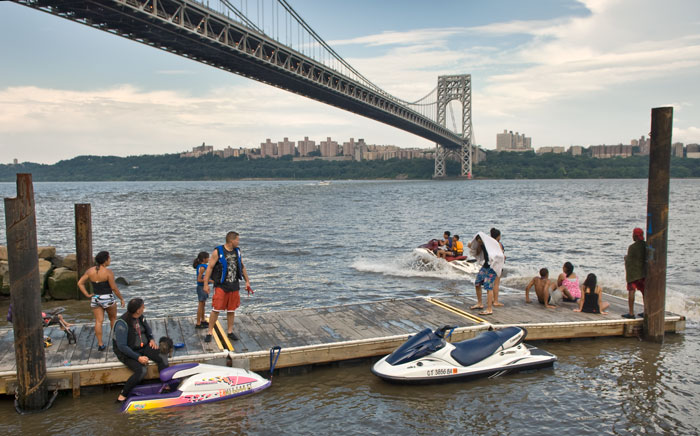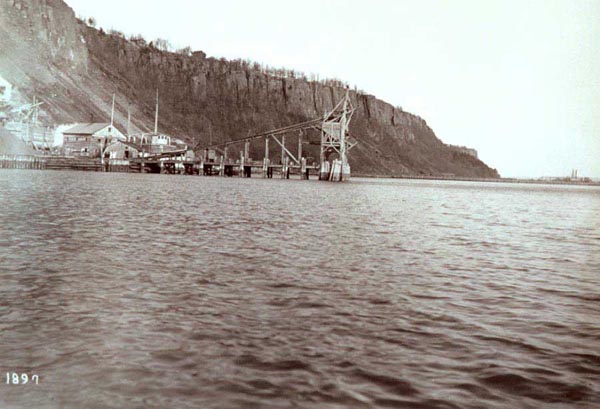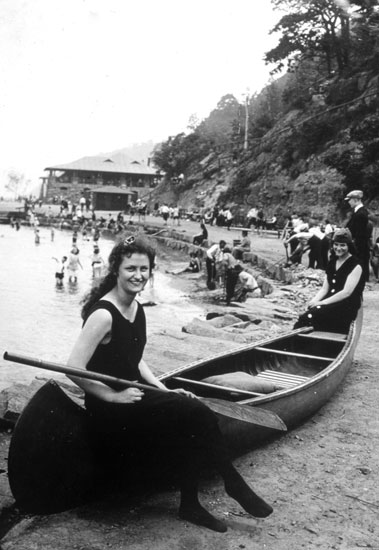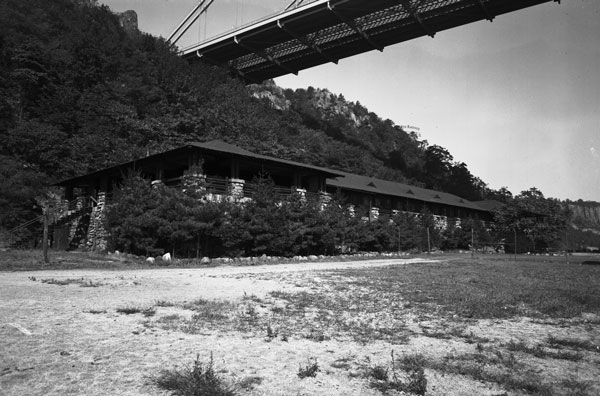Hazard’s
A “Cliff Notes” Story
May 2011
Two years ago, we marked the centennial of the Palisades Interstate Park’s dedication at Alpine Landing in 1909. Of course, when a park gets into the hundred-year-plus range, lesser milestones come and go on a fairly regular basis. This year, for instance, we mark the golden jubilee of the Hazard’s Dock boat launching ramp, directly beneath the New Jersey tower of the George Washington Bridge. First opened in the summer of 1961, and still used by hundreds of boaters, jet-skiers, and paddlers each year, the site has an intriguing history all its own, both before and since its acquisition by the Park Commission.

The ramp takes its curious name from the Hazard Powder Company, a Connecticut explosives manufactory founded by Colonel Augustus George Hazard, which in the 1890s operated a dock for the delivery and storage of high explosives for the massive Carpenter Brothers’ quarry just upriver. (Nearby was yet another dock operated by a manufacturer of explosives, this one with a name more familiar to us today: the DuPont dock.)

The newly-formed Palisades Interstate Park Commission acquired the Hazard property in 1902 for $2,100. In 1914, the Commission improved the area by building a “landing beach” for rowboats and canoes and a pair of “ice breakers” (stone jetties to protect the docks and beach in winter). Stairways were built to the top of the cliffs, to make the area accessible to New Yorkers coming by trolley to Fort Lee from the 125th Street–Edgewater ferry, as well as to trolley passengers from Englewood and Tenafly.
In the following year’s Annual Report, for 1915, “as bathing has become more popular each season,” the Commissioners reported that, as an experiment, “a number of scow loads of crusher screenings [sand created by the stone-crushing process] were brought down from the quarries and placed along the rough beaches,” including at Hazard’s.
In the Annual Report for 1918, the Commissioners reported that, by the close of the previous season, the demand for bathing facilities in the park had become such that plans for a “commodious and well equipped” bathhouse had been drawn up:
The Hazards bath house* was finished and opened to the public on July 7, 1918. The building is 200 ft. long by 62 ft. wide, constructed of stone in its first story and topped by a rustic pavilion. The lower floor is entirely devoted to dressing rooms, lockers and shower baths. …
At the beginning of the 1918 season, 500 lockers were installed and these were immediately followed by 500 additional lockers made necessary by the instant popularity of the bath house and the bathing beaches.
… The average Sunday attendance was 1,563 and on week days 491 persons. … At the end of the season it was seen that additional lockers must be provided if the public demand is to be met next season. The Commissioners have accordingly determined to purchase an additional 1,000 lockers before the summer of 1919 and thus equip the bath house to its full capacity.

A pedestrian-only ferry from 158th Street to the Hazard dock also began operating during the warm-weather months that year, to supplement the big year-round ferries from Manhattan to Edgewater and Englewood Cliffs.
Ten years later, in 1927, “construction of the new Hudson River Bridge from Fort Washington Point … to Fort Lee … which bridge enters and spans the park in the immediate vicinity of Hazzards Dock” led the Commissioners to arrange with the Port Authority, which was building the bridge, “that the Port Authority, in consideration of the temporary diversion from park purposes of the bath house, the dock and the lunch stand at Hazzards Landing, replace these structures with like buildings at Carpenter’s Point, some 1,000 feet north of the bridge zone.”
Until the new bridge opened at the end of 1931 (when it was christened the George Washington Memorial Bridge) the big stone bathhouse at Hazard’s remained closed. It reopened in 1932, but only operated for a few more years, closing in 1938. (See “The ‘Mystery’ of the Beaches” for a detailed discussion of the reasons why our Hudson River bathing beaches closed during this time.)
In 1941, the big bathhouse was razed by the WPA, the Works Progress Administration.

Twenty years later, in May 1961, the New York Times reported that “boatmen who move their craft around on trailers have something to look forward to … a new launching ramp under the George Washington Bridge.” The new launching area had parking for up to a hundred cars with boat trailers.
Fifty years down the road, and on a nice summer day, boaters find they may need to bring a bit of patience along with their PFDs and sun screen. The Coast Guard Auxiliary regularly conducts safety inspections at the ramp, and we now permit car-top boats to use the facility along with trailer-towed boats and jet skis.
Funny to think how beneath all that activity there lies a dock once used to blast the mighty Palisades — and the memories of a big stone bathhouse that saw a generation of Americans come to their new park to cool off for a bit.
EN
*“Hazard’s” was spelled both with and without an apostrophe, and with one Z and two, in the Annual Reports; likewise, “bathhouse” was written as both one word and two, capitalized and not. (When quoting the Reports, we reproduce the words as they appeared.)

